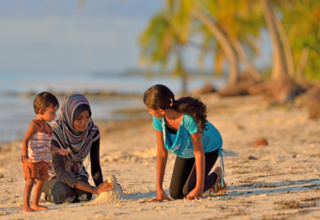International Day of the Girl Child
What kind of future do we wish to create for Asia and the Pacific?
The answer to that sweeping question, in large part, lies in how we care for the girls of today – in particular the more than 325 million girls aged 10 to 19 across our region.
We pose this question at a crucial time, when our region – and our world – are embarking on the 2030 Agenda for Sustainable Development, adopted by the United Nations last month, which seeks to achieve a life of dignity for all, leaving no one behind.
By 2030, the adolescent girls of today will form a significant proportion of the workforce – leaders, innovators, teachers. Many will also be mothers and caregivers for a new generation. But many others could be left behind, unless we create and sustain opportunities for them to craft their own future.
Imagine a girl standing at the fork of a road.
One branch will make it more likely that she can fulfill her potential -- school and higher education, gainful employment, adult marriage to a partner who will love and respect her, healthy children, the ability to invest resources for the wellbeing of her own children and, ultimately, a secure old age.
The other branch, however, makes it harder and adds to the risks she faces -- child marriage, leaving school, early and unwanted pregnancies, unsafe childbirth, violence and abuse, informal and erratic employment, a hostile home environment and possible displacement, and an insecure old age.
If every adolescent girl receives a quality secondary education, there will be fewer child deaths, far less malnutrition, and far less teen pregnancy and child marriage. Our workforce will be more productive, our economies will be sounder, our countries will be stronger and our societies more caring.
We ignore the needs and education of adolescent girls at our peril. And if we continue to do so, everyone in our region and in our world – communities, businesses, families, children – will suffer.
But for adolescent girls to be the formidable force for good we need them to be, they need support to overcome inequalities and discrimination on several fronts.
At present far too many across Asia and the Pacific are constrained by social norms, deeply-rooted gender roles and outright discrimination – including a widespread preference for boys over girls.
Too often girls are aborted before they are born or even killed at birth, fed more poorly than boys, kept out of school, forced to marry in childhood, suffer violence at the hands of their partners, excluded from decent employment and marginalized in old age.
Women and girls often act as first responders on the frontlines in global crises, holding their communities and families together. Consequently, they are often more impacted than men and boys by economic upheaval, poverty, food insecurity, climate change and lack of healthcare.
For their sakes – and for ours as a whole – we need to ensure that adolescent girls are not invisible.
Services and programmes must target the specific needs of girls aged 10 to 19, and address the barriers and disadvantages adolescent girls face.
Services and programmes must also be underpinned with the realization that adolescent girls are not just recipients of interventions and support, but are recognized as agents of development and change.
Laws prohibiting discrimination in all forms must be passed and enforced.
Investing in adolescent girls is not just fair or right or decent – it’s also smart.
The evidence is clear. Interventions that improve the health, safety, education and the lives of the millions of girls and young women in the Asia-Pacific region will also significantly improve all our lives, especially those of our children and grandchildren — female and male alike.
On this International Day of the Girl Child, on the cusp of the era of the 2030 Global Goals, we all have a responsibility to safeguard their rights to education, health, protection and participation – governments, civil society and United Nations agencies alike.
Invest in and support education, skills training and access to information technology to transform the lives of adolescent girls and prepare them for life, jobs and leadership.
Provide adolescent girls with timely and age-specific information and services on puberty, menstrual hygiene management, nutrition and sexual and reproductive health.
Enact and consistently implement policies to protect adolescent girls from any form of violence, child marriage, trafficking and sexual exploitation.
Help all girls to be the women they can be, so that the world can have the future we want.
Roberta Clarke, UN Women Regional Director, Asia Pacific
Gwang-Jo Kim, UNESCO Asia and Pacific Regional Bureau for Education Director
Daniel Toole, UNICEF Regional Director, East Asia and the Pacific
Yoriko Yasukawa, UNFPA Regional Director, Asia Pacific
Some of the major challenges adolescent girls face in Asia and the Pacific:
- An estimated 16.3 million adolescent girls are excluded from secondary education (UNESCO, 2013)
- Nearly half of the girls in South Asia and 1 in 5 girls in East Asia Pacific are married before 18 (UNICEF, 2014)
- 19% of young women in developing countries become pregnant before age 18. This figure is 22% in South Asia and 8% in East Asia Pacific (UNFPA, 2013)
- There are approximately 5.4 million adolescent pregnancies annually (UNFPA, 2013)
- The cost of adolescent pregnancy as a share of gross domestic product could be as high as 30% over a girl’s lifetime (World Bank, 2011)
- Nearly a quarter of girls aged 15 to 19 reported being victims of violence after turning 15 (UNICEF, 2014)




